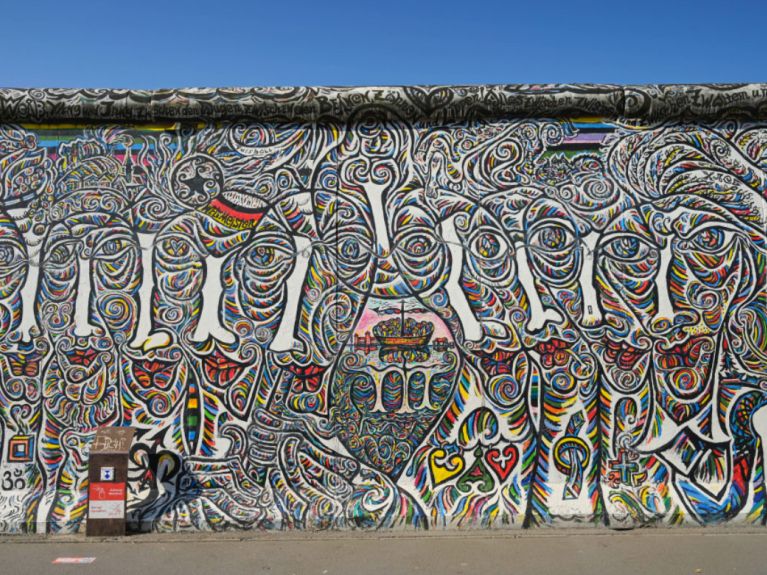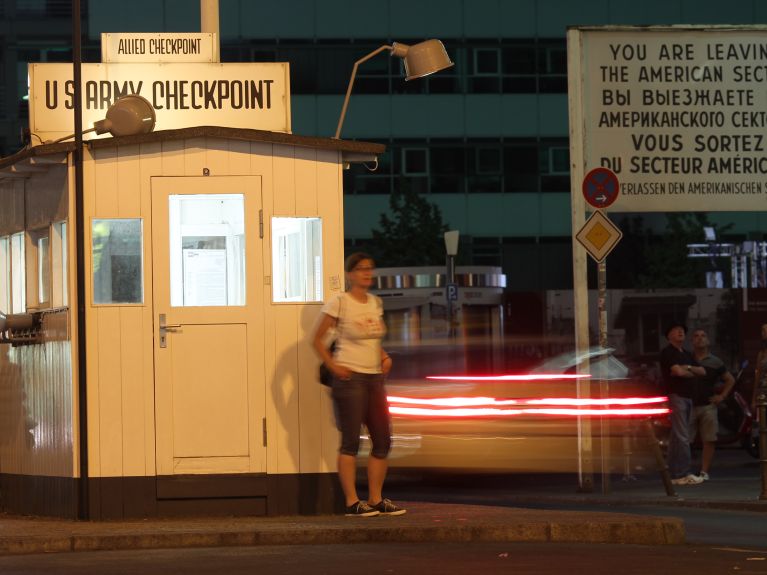Border experience
Where German-German history becomes tangible: various remembrance sites ensure that the past is not forgotten.

For many people the GDR was consigned to history long ago; the division of Germany now lies over three decades in the past. As a result, remembrance sites that ensure this period is not forgotten are becoming all the more important.
Berlin Wall
The Wall may now be history, but a few pieces are still standing. The longest of them is the world-famous East Side Gallery in the Berlin district of Friedrichshain. One hundred and eighteen artists from 21 countries have immortalised themselves in graffiti along the 1.3-kilometre-long section, one of the images showing the iconic “fraternal kiss” between GDR Council of State Chair Erich Honecker and the leader of the Soviet Union, Leonid Brezhnev.
The main Berlin Wall Memorial in Bernauer Strasse between the Mitte and Wedding districts leads visitors deeper into the history. Hardly any other space gives visitors such a vivid feeling of what the period of German-German division was like: the death strip has been reconstructed here with a watchtower and patrol road, while a Window of Remembrance shows portraits of people who lost their lives at the Wall. Bernauer Strasse was already a special border location even in GDR times. A cemetery once used to lie where today there is an extensive park landscape. Over 1,000 graves had to be relocated for the construction of the Wall, and the cemetery chapel was demolished. Today the memorial includes the modern Chapel of Reconciliation, where the victims of division are regularly remembered.

Checkpoint Friedrichstrasse
While the Wall along Bernauer Strasse tore apart a church congregation and many families and friends, it also ensured that a form of “cross-border traffic” had to be established between the two German states. That was why the Palace of Tears was built in 1962; its official name: Border Checkpoint Berlin-Friedrichstrasse. Today this checkpoint building is the site of a moving exhibition. Photos, documents, sound recordings, pieces of luggage and a control counter that has been preserved in its original state provide an authentic picture of the kind of anguish the division of Germany repeatedly caused innumerable people over decades.
Death strip through the middle of a village
The border also drove a death strip through small villages – for example, the settlement of Mödlareuth, roughly 80 kilometres south of Jena. After the Second World War the narrow Tannbach that runs through the middle of the village became part of the Iron Curtain between East and West. Eastern Mödlareuth belonged to the Soviet occupation zone; the western part fell under the protection of the United States. During the initial postwar years citizens were still able to cross to the other side of the stream with a pass, but in 1952 the SED regime built a tall fence and then, in 1966, a 700-metre-long concrete wall that transformed the village with 50 inhabitants into “Little Berlin”. Sections of the Wall and the old border tower are now part of the German-German Museum Mödlareuth. A border still exists here today, but it is only an invisible one between two German Länder (states): the west of Mödlareuth is Bavarian, while the eastern part belongs to Thuringia, but everyone can now cross the narrow Tannbach without any problem.

Border land was also transit land
A good 250 kilometres to the northwest lay the former Duderstadt-Worbis border crossing, where the division of Germany separated the previously closely linked settlements of Gerblingerode in the West and Teistungen in the East. The Borderland Museum Eichsfeld looks back on life in divided Germany. In the Eichsfeld District this was characterised by so-called “small cross-border traffic”, which enabled people from the West to at least visit family and friends in the GDR from 1973. Almost six million border crossings were registered in Duderstadt-Worbis between 1973 and 1989: an enormous number that shows how massively division affected people’s lives and relationships. The museum site encompasses the border installations including the observation bunker and watchtower, in which visitors can still see the control and signal systems of the GDR border guards.
Refugees were to be “annihilated”
The brutal response to any attempts to escape is illuminated by the Border Museum Schifflersgrund near Bad Sooden-Allendorf. The exhibition here places special emphasis on the fate of those who tried to leave the GDR despite the threat to life that involved. Twenty-six people died during escape attempts along the then inner-German border between Hesse and Thuringia alone. An equally sad and shocking historical document is the text of the “order to fire”, whose existence was always officially denied by the GDR. It obliged GDR border soldiers “to annihilate” refugees.
Dieses YouTube-Video kann in einem neuen Tab abgespielt werden
YouTube öffnenThird party content
We use YouTube to embed content that may collect data about your activity. Please review the details and accept the service to see this content.
Open consent form


